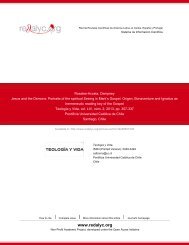A Key Concept in Modern Translation Theory - Redalyc
A Key Concept in Modern Translation Theory - Redalyc
A Key Concept in Modern Translation Theory - Redalyc
Create successful ePaper yourself
Turn your PDF publications into a flip-book with our unique Google optimized e-Paper software.
76 EQUIVALENCE REVISITED: A KEY CONCEPT IN MODERN TRANSLATION THEORY<br />
And the author further clarifies:<br />
“[…] with the theoretical concept of equivalence it is postulated above all that<br />
there exists a translation relationship between one text (or text elements) <strong>in</strong> a language<br />
L2 (TL-Text) and another text (text elements) <strong>in</strong> a language L1 (SL-text). The concept of<br />
equivalence does not say anyth<strong>in</strong>g about the nature of this relationship: it should be<br />
determ<strong>in</strong>ed additionally.” (ibid, p.24) 12<br />
In an attempt to determ<strong>in</strong>e the nature of the relationship that underlies the<br />
concept of equivalence <strong>in</strong> order for this notion to be useful <strong>in</strong> the analysis<br />
(description, classification and explanation) of translation cases, Koller (2000)<br />
proposes to specify and differentiate this concept as follows:<br />
“There are different attempts to systematize the magnitude of equivalence. I<br />
have proposed myself (Koller 1992:214ff) to apply the follow<strong>in</strong>g five frames of equivalence:<br />
(1) the extral<strong>in</strong>guistic situation, that is mediated <strong>in</strong> a text (=denotative equivalence), (2)<br />
the connotations mediated <strong>in</strong> the text through the type of verbalization (specially through<br />
the specific selection among synonymous or quasi-synonymous possibilities of<br />
expression) <strong>in</strong> relation to stylistic level, sociolectal and geographical dimension, frequency,<br />
etc. (=connotative equivalence), (3) the text and language norms (norms of use), that are<br />
valid for certa<strong>in</strong> texts (=text-normative equivalence), (4) the receiver (reader) to whom<br />
the translation is addressed and who could receive the text, <strong>in</strong> which the translation is<br />
‘placed’, based on his/her conditions for comprehension, <strong>in</strong> order for the translation to<br />
fulfill its communicative function (=pragmatic equivalence), (5) certa<strong>in</strong> aesthetic, formal<br />
and <strong>in</strong>dividual characteristics of SL-text (=formal-aesthetic equivalence).”(p.24) 13<br />
12<br />
“[...] mit dem theoretischen Begriff der Äquivalenz wird zunächst nur postuliert, dass<br />
zwischen e<strong>in</strong>em Text (bzw. Textelementen) <strong>in</strong> e<strong>in</strong>er Sprache L2 (ZS-Text) und e<strong>in</strong>em Text (bzw.<br />
Textelementen) <strong>in</strong> e<strong>in</strong>er Sprache L1 (AS-Text) e<strong>in</strong>e Übersetzungsbeziehung besteht. Der Begriff<br />
Äquivalenz sagt dabei noch nichts über die Art dieser Beziehung aus: diese muss zusätzlich<br />
bestimmt werden.” (p.24).<br />
13<br />
Es liegen verschiedene Versuche vor, die Bezugsgrössen der Äquivalenz zu systematisieren.<br />
So habe ich selbst vorgeschlagen (Koller 1992:214ff), folgende fünf Äquivalenzrahmen anzusetzen:<br />
(1) der aussersprachliche Sachverhalt, der <strong>in</strong> e<strong>in</strong>em Text vermittelt wird (= denotative Äquivalenz),<br />
(2) die im Text durch die Art der Verbalisierung (<strong>in</strong>sbesondere: durch spezifische Auswahl unter<br />
synonymischen oder quasi-synonymischen Ausdrucksmöglichkeiten) vermittelten Konnotationen<br />
bezügich Stilschicht, soziolektale und geographische Dimension, Frequenz etc. (= konnotative<br />
Äquivalenz), (3) die Text- und Sprachnormen (Gebrauchsnormen), die für bestimmte Texte gelten<br />
(= textnormative Äquivalenz) , (4) der Empfänger (Leser), an den sich die Übersetzung richtet und<br />
der den Text auf der Basis se<strong>in</strong>er Verstehensvoraussetzungen rezipieren können soll, bzw. auf den<br />
die Übersetzung “e<strong>in</strong>gestellt” wird, damit sie ihre kommunikative Funktion erfüllen kann<br />
(=pragmatische Äquivalenz) , (5) bestimmte ästhetische, formale und <strong>in</strong>dividualistische Eigenschaften<br />
des AS-Textes (=formal-ästhetische Äquivalenz).”
















